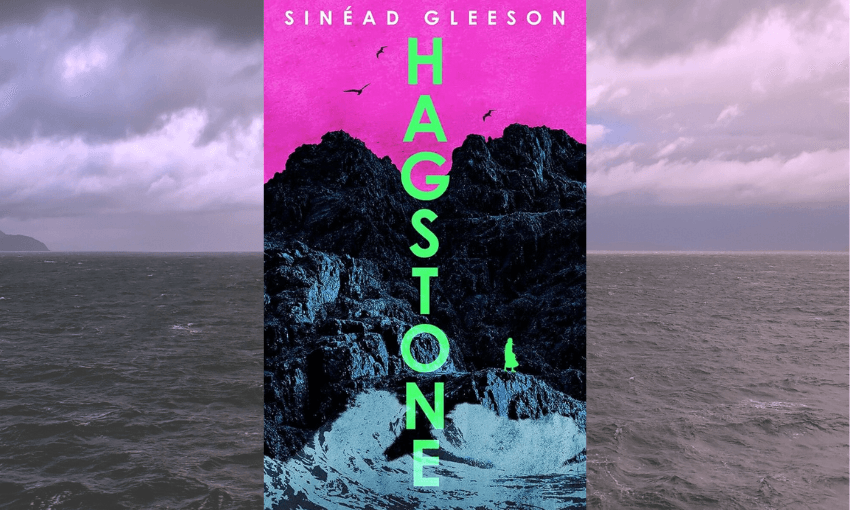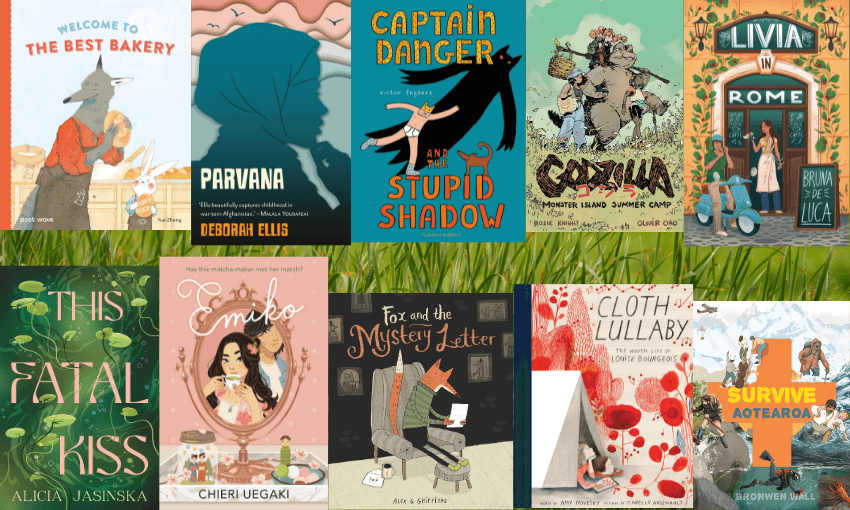Claire Mabey reviews the haunting and sexy debut novel from Sinéad Gleeson, who is about to touch down in Aotearoa for a string of live events.
When Irish writer Sinéad Gleeson was in Aotearoa in 2018 with her spectacular collection of essays, Constellations, she told me she was working on a book about living on islands. Six years later we have a deliciously moody debut novel – Hagstone – a salty, windswept story alive with ideas, sex, art, mystery, and the allure of seclusion and sects.
Shortly before I started reading Hagstone (gulped it, for the prose skips and leads the reader on and in) I listened to a podcast of a conversation between art writers Jennifer Higgie and Brian Dillon. In many ways it was the perfect primer to take with me into Gleeson’s novel. Higgie is author of The Other Side: A Journey into Women, Art and the Spirit World, and Dillon is the author of an idiosyncratic essay collection about images, artists and experiences that resonate with each other, called Affinities. Their conversation is a perfect example of what it is about the attempt to talk about art that I love: simultaneously loose and precise; vague and particular – like moonshine, or sand, or sound. It’s the kind of conversation that might make an ACT MP want to cry. There are no concrete answers to why an artist, why this image, why that metaphor. A definitive answer isn’t the point: it’s the adventure of the attempt to get there and what freedoms the journey towards articulation will afford your worldview that matters. It’s about keeping the faith in what you’re doing while also being open to uncertainty.
Hagstone – in part about the artist’s life and search for the “guiding metaphor” (Dillon’s words: a mechanism he uses when trying to keep true to what he’s writing about) – shares interests with Higgie’s The Other Side, and Dillon’s Affinities (people and work Gleeson knows intimately), and Gleeson’s own Constellations: Reflections from Life. The essays in these books seek to unfold lived experience by looking and reflecting: by turning works of art, and their makers, over and over to find what they might tell us about struggle, or liberation, or pain, or nature, or pleasure, or the supernatural, or what it is to experience life on earth from the vantage point of a human body, and how. The difference is that in Hagstone, Gleeson revels in the tools of fiction and the result is breathless, fierce, cinematic and fun.
Hagstone’s heroine is Nell, an artist and a long-time inhabitant of the Irish island upon which the story is set. It’s the kind of island that gets romanticised for its heady relationship with the weather, its green, its singular pub, and its bleakness. In this novel it proves the perfect petri dish for an entanglement of related ideas and uncanny happenings. Where Gleeson’s Constellations uses nonfiction to explore the relationship between bodies, pain and art (Gleeson has had more than her fair share of medical interventions thanks to arthritis and leukaemia), Hagstone rushes in with a lyrical physicality that is agile, and charged with sexual energy: “The Sea is steady for now. The Land readies itself.” “To the places they sometimes devoured each other.” “Wave-fucked. That’s how Nell describes the island.”
It’s glorious, that “Wave-fucked.” Pleasure and pain, give and take, wear and thrust. The constant relationship between land and sea is familiar to us here in Aotearoa: the life-giving slurp of the water; its moods; and the increasingly menacing nature of the mass thanks to the climate crisis. Nell immerses in the island’s sea – the cold freedom of swimming: but there are near misses, the ever present danger of something wild and unpredictable.
Hagstone’s island setting offers the infinite rhythm of waves, which mirror the character’s own interests and desires (Nell is a liberated, free-moving woman, which is a contrast to other recent Irish stories that draw on a deeply troubling history of oppression and misogyny – such as Claire Keegan and Audrey Magee, whose island novel The Colony is mirror of colonisation, and Paul Lynch’s dystopia) but also gives us handy metaphors: in the Tarot and other esoteric forms of storytelling (as discussed in Higgie’s The Other Side, in the chapter on Pamela Colman Smith), the sea represents the subconscious, the creative potential that needs to be shaped, ordered into form.
The inherent creative potential of nature is core to Nell’s creations, some of which is what’s known as “land art”: outdoor sculptures made from the materials of nature and transformed, eventually destroyed, by nature’s entropy (like Spiral Jetty, the famous example from the late, magnificent Robert Smithson). Reluctantly, Nell tries to explain what she’s trying to do: “I think I’m trying to make something about infinity. Or symbols of infinity. Ever heard of the ouroboros? You know, the snake eating its own head? Or the lemniscate – the thing that looks like a number eight on its side. I keep coming back to circles. The whole infinite line thing. There’s a French artist – Louise Bourgeois – and she made spirals. My plan, a sort of homage, is to make the biggest one I can, on Banshla.”
Louise Bourgeois is also famous for her series of giant spiders: towering, leggy creatures of craggy black steel, that remind me of the loving aliens from the film Arrival. The biggest one of the spiders is called ‘Maman’ and is about the artist’s mother who Bourgeois described as “deliberate, clever, patient, soothing, reasonable, dainty, subtle, indispensable, neat, and as useful as a spider”. In Hagstone the leader of a secretive community called the Iníons is also called Maman.
While one side of Nell’s island is familiarly work-defined and tourist-bothered, the other is secretive and ripe for a gripping mystery with affinities to the films Midsommar and The Wicker Man. The word Iníon in Irish means maiden, or daughter: a perfectly unsettling word for a reclusive community of women, each one attracted to the island for the opportunity to shuck their pasts, give up on society in favour of monastic-style living, self-sustaining, Samhain-celebrating, Danu-worshipping, divorced from a world infused with men.
Years ago, when writer (and Tarot specialist) Jessa Crispin came to New Zealand to talk about her book Why I am not a feminist: A manifesto, I asked her what her solution to a misogynistic society might be. “A modern convent,” she answered. Where women could do good work for others, make art, fuck if they wanted to. Men could visit but it wouldn’t be theirs to own or exploit or have opinions about. I have thought about this idea a lot: it’s appealing, to create your own community, trade one set of politics for a fresh start at it. God knows it’s been trialled over and over and over again: by all manner of religions, by hippies, by Circe. But can it ever work? Can you ever overcome the foibles of hierarchy, power thirsts, can the collision of individual pains and desires ever be homogenised into one harmonious system? Should you even try?
These questions are at the heart of the Iníon plot in Hagstone. Nell is invited to Rathglas, the Iníons’ converted convent, to learn about the women, talk and record their histories in a “bible”, a work of craft reminiscent of Neva Elliott’s The Elliott Condensed Bible, which Gleeson lists among the many artworks that inspired the novel. It also reminded me of the Bayeux Tapestry: a handmade history, a tactile litany of battles, most likely crafted from the hands of women. I came to think of the Iníon community as an attempted artwork in itself: the shaping of injuries into some kind of new order, the same as Nell’s attempt at moulding sand and stone into something beautiful and of the place itself.
But in this novel, the mysteries and drama of the Iníon plot is both central and unimportant. What thrilled me about this book is the intensity of what it lets in; what haunts the place and people on the island haunts us, the readers, too: the island is plagued by “recurrent hum phenomenon”, a sound that turns some (mostly men) mad, makes women bleed; there is a sudden pelt of dead seagulls; a famous male movie star blunders onto the island, a metonym for crashingly bad, extractive Hollywood “art”; the loud history of women being silenced, “witches” killed; a dead whale washes up: “Muscles, once taut, all torsion, flop to one side of a large wound. It is almost vulvic, gleaming.”
The power of women’s bodies pulses between and behind and inside Gleeson’s sharp, glittering prose. The language is chewsome; the chapters zing and lift, helped by the deft use of the dash to mark lines of dialogue (an invention I’m not sure I’ve seen anywhere else but one I’ll be pinching). This is a slippery novel about a sturdy woman, an artist, who relies on herself, who weathers uncertainty, even creates from it. Even while Nell is an oddity in her own home – whispered about, a suspected uncanny, thanks to her self-sufficiency, the way she can make her own medicines, live alone, have sex in the woods – she is happily “unmarriable. Thank fuck for that” – and that means she’ll never be relegated from artist to “someone’s wife”. Nell travels inside the island’s mysteries, failures, bleeds, and shocks, only to come out whole and ready.
We are currently in a spell of enchantment with Irish writing. Which is not a particularly new phenomenon as Ireland has always valued and supported culture as a powerful export, an economic stimulus, a vehicle for processing collective trauma. Gleeson’s Hagstone is a gem among Irish offerings but it is also a timeless hum to the powers of language, art and resistance, a spiral that women have been building since forever.
Hagstone by Sinéad Gleeson ($49, Fourth Estate) is available from Unity Books Wellington and Auckland. Gleeson is appearing in Christchurch on 13 May with WORD Christchurch; in Wellington on 14 May with Verb Wellington; and in will appear in four events in Auckland between 17 – 19 May at Auckland Writers Festival.



